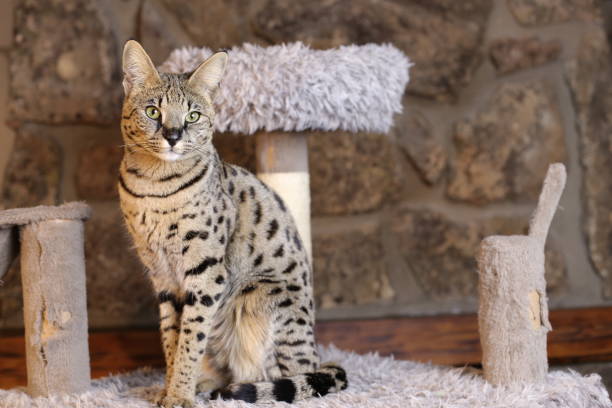Savannah Cat

History:
The Savannah cat is a hybrid breed created by crossing a domestic cat with a serval, a wild African feline known for its long legs and spotted coat. The first known Savannah cat was born in 1986 in the United States, and the breed gained popularity for its exotic appearance paired with a more domestic temperament. By the early 2000s, selective breeding stabilised the breed, and it was recognised by the International Cat Association (TICA) in 2001. Savannahs are classified by filial generations (F1 through F5 and beyond), indicating their percentage of wild ancestry. The closer they are to their several parent (e.g., F1 or F2), the larger and wilder in behaviour they tend to be. Over time, Savannahs have become popular among cat enthusiasts who seek a striking, active, and highly intelligent companion.
Size: Medium to large (varies with generation)
Height: 35–45 cm (F1-F3); smaller for later generations
Weight: 5.5–11 kg (males larger)
Life Expectancy: 12 to 20 years

Breed Appearance:
Savannah cats have a tall, lean, and muscular frame with long legs, a short tail, and large, upright ears set close together on the top of the head—features reminiscent of their serval ancestry. Their heads are small in proportion to the body, with a long neck and prominent cheekbones. The coat is short and dense, typically golden or tan with bold black or dark brown spots, though silver, smoke, and black variants exist. Their eyes are hooded and almond-shaped, often gold, green, or hazel. The tail is thick with black rings and a solid black tip. Their striking wildcat appearance makes them one of the most visually unique domestic breeds.
Health & Care:
Savannah cats are generally healthy, but some early-generation cats may inherit wild traits that complicate veterinary care or anaesthesia. They may also be prone to hypertrophic cardiomyopathy (HCM), a heart condition, so regular checkups and responsible breeding are important. Their short coat requires minimal grooming—occasional brushing to remove loose hairs and routine hygiene like dental care and nail trimming. Savannahs are highly energetic and intelligent, so they benefit from interactive toys, climbing spaces, and consistent mental stimulation to prevent boredom and stress-related behaviours. Later generations (F4 and beyond) are usually easier to care for and more suited to typical domestic environments.

Living Conditions:
Savannah cats need space to climb, jump, and explore—ideally, a home with vertical spaces, cat trees, and safe outdoor enclosures. They can adapt to apartment living if their physical and mental needs are met. While very affectionate with their humans, Savannahs are not lap cats; they prefer active engagement and may even play fetch or walk on a leash. They are curious and clever, often learning how to open doors or cabinets. While some do well with other pets, early generations can be territorial or dominant. Later generations are typically more sociable and may adjust well to multi-pet households and older children.
Grooming:
Grooming a Savannah cat is relatively easy due to its short, dense coat. Weekly brushing helps remove loose fur and maintain coat health, especially during seasonal shedding. Bathing is rarely needed unless the cat gets into something messy. Their large ears should be checked and cleaned regularly to prevent wax buildup. Routine dental care, nail trimming, and occasional eye cleaning are also recommended. Despite their wild appearance, Savannahs are not high-maintenance in grooming, but they do require significant interaction and exercise to stay happy and healthy.

Advantages:
-
Savannah cats are incredibly intelligent and trainable, often learning commands, walking on leashes, or playing games like fetch.
-
Their exotic, wildcat look makes them a visually stunning pet that attracts attention and admiration.
-
They are loyal and bond closely with their owners, often following them from room to room and interacting actively.
-
Savannahs are highly energetic and enjoy interactive toys, puzzles, and exercise, making them great companions for active households.
-
Later generations (F4 and beyond) tend to be more adaptable, social, and easier to care for than earlier generations.
Disadvantages:
-
Savannah cats require a lot of stimulation and exercise; without it, they may become destructive or stressed.
-
They are not legal to own in all regions—some areas restrict or ban hybrid cats, especially early generations.
-
Early-generation Savannahs (F1–F3) may retain more wild behaviours and be less predictable or sociable.
-
They may not get along with other pets or young children, especially if poorly socialised.
-
Due to their rarity and complex breeding, Savannahs can be expensive to purchase and insure, and veterinary care may be more complicated than for typical domestic cats.

